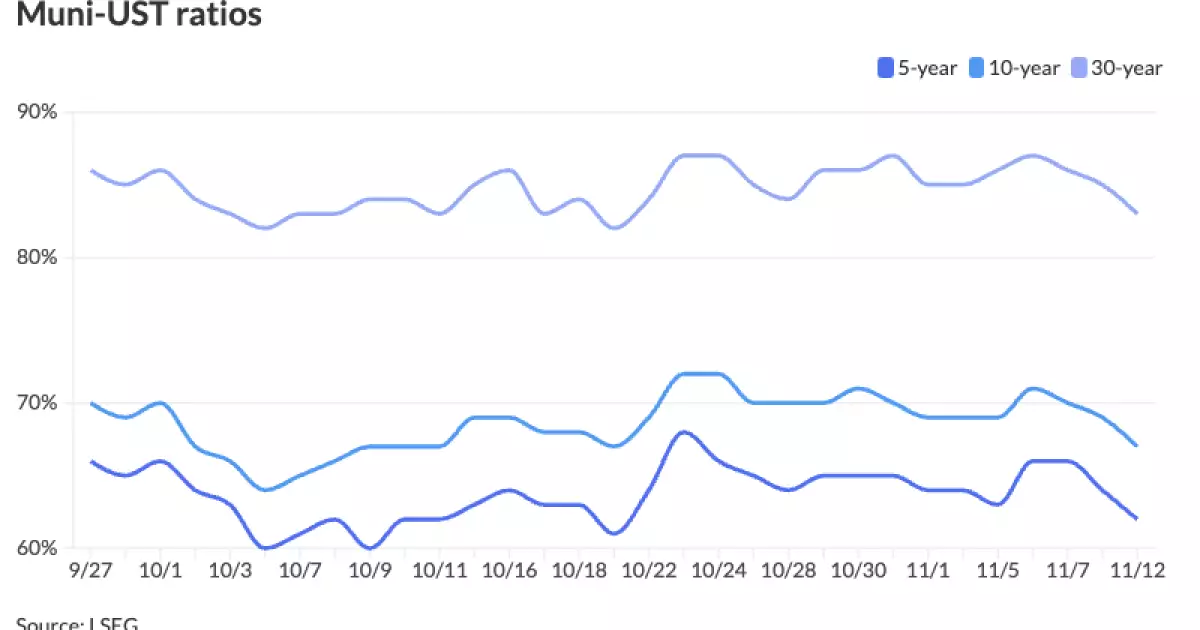The municipal bond market is experiencing noteworthy developments as it adapts to fluctuating economic conditions, Federal Reserve actions, and evolving investor sentiment. Recent trading sessions indicate a mixed performance for municipals, which remain largely unaffected by declines in U.S. Treasury (UST) yields, while equity markets show signs of a cooling trend after a previous surge. This article takes a comprehensive look at recent activity within the municipal bond space, offering insights into yield movements, investor behavior, and coming issuances.
On a recent Tuesday, the municipal bond market displayed a patchwork of performance across various yield curves. While larger shifts in the UST market resulted in somewhat larger losses—up to 12 basis points on the 10-year note—the municipal sector showed resilience. For instance, as of 3 p.m. EST, triple-A yields fluctuated, with minor increases and decreases observed across one- to thirty-year horizons. According to data from Refinitiv Municipal Market Data, the two-year municipal to UST ratio rested at 61%, with values fluctuating from 60% to 84% for maturities ranging from three to thirty years. This contrasting performance underscores the relative stability of the municipal market amid Treasury fluctuations.
Municipal bonds continue to maintain a strong showing not just in immediate performance, but also on longer-term averages. The Bloomberg Municipal Index has demonstrated a positive return of 0.52% for November and 1.33% for the year thus far, while USTs have struggled to keep pace, remaining flat in November and yielding a modest 1.37% year-to-date. Observations by fixed-income experts like Sudip Mukherjee from UBS suggest that this trend is likely to accelerate, especially after a brief period of muted trading that followed a significant rate rally last Friday, attributed to easing election-induced volatility and a 25 basis point rate cut by the Federal Reserve.
A key factor driving demand in the municipal bond market is the notable reinvestment activity, with considerable capital influx recorded. As of earlier this month, a substantial amount—$14.3 billion in principal and $7 billion in interest—was reinvested as fixed-income professionals recalibrated their portfolios. Furthermore, the municipal mutual funds have reported $1.263 billion in inflows last week, marking a remarkable 19 consecutive weeks of positive inflow activity. While this suggests that investors are increasingly favoring municipal bonds, notable hesitations remain among financial advisors who are cautious about potential taxable capital gains distributions later in the year.
Looking ahead, while overall demand seems strong, strategists like Pat Luby anticipate a possible slowdown in net new-money flows into mutual funds as investors navigate year-end considerations. Nevertheless, Luby pointed out that a slowdown does not necessarily equate to diminished investor interest, indicating the sector’s enduring attractiveness for risk-averse portfolios.
Upcoming Issuances and New Opportunities
As the year draws to a close, the municipal bond market anticipates a slew of significant issuances that could reshape the investment landscape. Analysts forecast that despite a meager visible supply—currently around $10.56 billion—the demand will likely sustain interest, especially as public institutions prepare for upcoming projects. For instance, a notable offering is anticipated from Houston, which plans to price $1 billion in revenue bonds for United Airlines Terminal Improvements on November 19.
Further enhancing market dynamism, several other agencies are gearing up for substantial issuances. The Maryland Department of Transportation aims to sell approximately $224 million of airport project revenue bonds, while various educational and housing authorities, including the Maricopa County Industrial Development Authority, also plan significant debt offerings. These new issuances create potential investment avenues for those keen on leveraging the benefits of municipal bonds amid favorable market conditions.
The municipal bond market is witnessing a compelling mix of resilience and opportunity as it navigates through economic ebbs and flows. With current offerings aligned with strong demand and attractive relative value, investors are keeping a close eye on upcoming issuances and market moves. Whether driven by reinvestment strategies or caution in the face of forthcoming tax implications, the future of municipal bonds remains vibrant, offering both challenges and opportunities in this intricate financial landscape.


Leave a Reply